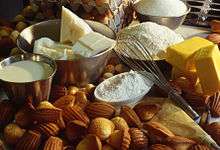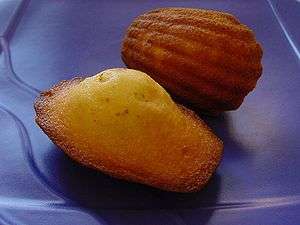Madeleine (cake)
|
The genuine petite Madeleine de Commercy | |
| Alternative names | Petite madeleine |
|---|---|
| Type | Cake |
| Place of origin | France |
| Region or state | Commercy and Liverdun, Lorraine |
| Main ingredients | Flour, sugar, eggs, almonds or other nuts |
|
| |
The madeleine (French pronunciation: [mad.lɛn], English /ˈmædleɪn/ or /ˌmædlˈeɪn/[1]) or petite madeleine ([pə.tit mad.lɛn]) is a traditional small cake from Commercy and Liverdun, two communes of the Lorraine region in northeastern France.
Madeleines are very small sponge cakes with a distinctive shell-like shape acquired from being baked in pans with shell-shaped depressions. Aside from the traditional moulded pan, commonly found in stores specialising in kitchen equipment and even hardware stores, no special tools are required to make madeleines.
A génoise cake batter is used. The flavour is similar to, but somewhat lighter than, sponge cake. Traditional recipes include very finely ground nuts, usually almonds. A variation uses lemon zest, for a pronounced lemony taste.
English madeleines also use a génoise sponge but they are baked in dariole moulds. After cooking, the cakes are coated in jam and desiccated coconut, and are usually topped with a glacé cherry.
History

Legend
Several legends exist attached to the "invention" of the madeleines. They have tended to center around a female character named Madeleine who is meant to have been at the service of an important character in the history of the Lorraine – although there is no consensus over the last name of the cook nor the identity of the famous character. Some consider that the illustrious patron was 17th-century cardinal and rebel Paul de Gondi who owned a castle in Commercy.[2] Others consider that the cook was named Madeleine Paulmier, who is said to have been a cook in the 18th century for Stanislaus I, duke of Lorraine and exiled King of Poland. The story goes that, in 1755, Louis XV, son-in-law of the duke, charmed by the little cakes prepared by Madeleine Paulmier named them after her, while his wife, Maria Leszczyńska, introduced them soon afterwards to the court in Versailles. Much beloved by the royal family, they conquered the rest of France in no time.[3] Yet other stories have linked the cake with the pilgrimage to Compostella, a pilgrim named Madeleine is said to have brought back the recipe from her voyage or a cook named Madeleine is said to have offered little cakes in the shape of a shell to the pilgrims passing through Lorraine.
Other stories do not give the cake a Lorraine origine and lay its invention at the feet of pastry chef Jean Avice, who worked in the kitchens of Prince Talleyrand. Avice is said to have invented the Madeleine in the 19th century by baking little cakes in aspic moulds.[4]
First recipes
The term madeleine to describe a small cake seems to appear for the first time in France in the middle of the 18th century. In 1758, a French retainer of an Irish Jacobite refugee in France, Lord Southwell, is said to prepare "cakes à la Magdeleine and other small desserts".[5]
Cakes à la Madeleine
On a pound of flour, you need a pound of butter, eight egg whites & yolks, three fourth of a pound of fine sugar, a half glass of water, a little grated lime, or preserved lemond rid minced very finely, orange blossomed praliné; knead the whole together, & make little cakes, that you will served iced with sugar.
Menon, Les soupers de la Cour ou L'art de travailler toutes sortes d'aliments, p.282 (1755).[6]
The apparition of the madeleine is representative of the increasing use of metal moulds in European baking in the 18th century (see also Canelés) but its commercial success dates back to the early years of the 19th-century. Several mentions of the madeleine are made by culinary writers during the Napoleonic era, in particular in the recipe books of Antonin Carême and by famous gastronomer Grimod de la Reynière.
In Commercy, the production at a large scale of madeleines is said to have began in the 1760s.[7] It is likely that the cakes were exported to Paris along the marmelade from Bar-le-duc and the croquantes from Rheims. Batch of madeleines tended to be marketed in white pinewood boxes from the neighbouring Vosges forest.
During the Bourbon Restoration era, the Commercy madeleines were sold in Paris for 30 centimes. Production picked up during the 1840s, and some 20,000 cakes were produced daily. The success of the madeleines of Commercy was further increased by the development of the railway which gave the producers an easy access to the Parisian market. By the end of the 19th century, the madeleine is considered as a staple of the diet of the French bourgeoisie.
The madeleine in the 20th century
Madeleines were chosen to represent France in the Café Europe initiative of the Austrian presidency of the European Union, on Europe Day 2006.
Literary reference

In In Search of Lost Time (also known as Remembrance of Things Past), author Marcel Proust uses madeleines to contrast involuntary memory with voluntary memory. The latter designates memories retrieved by "intelligence," that is, memories produced by putting conscious effort into remembering events, people, and places. Proust's narrator laments that such memories are inevitably partial, and do not bear the "essence" of the past. The most famous instance of involuntary memory by Proust is known as the "episode of the madeleine," yet there are at least half a dozen other examples in In Search of Lost Time.
No sooner had the warm liquid mixed with the crumbs touched my palate than a shudder ran through me and I stopped, intent upon the extraordinary thing that was happening to me. An exquisite pleasure had invaded my senses, something isolated, detached, with no suggestion of its origin. And at once the vicissitudes of life had become indifferent to me, its disasters innocuous, its brevity illusory – this new sensation having had on me the effect which love has of filling me with a precious essence; or rather this essence was not in me it was me. ... Whence did it come? What did it mean? How could I seize and apprehend it? ... And suddenly the memory revealed itself. The taste was that of the little piece of madeleine which on Sunday mornings at Combray (because on those mornings I did not go out before mass), when I went to say good morning to her in her bedroom, my aunt Léonie used to give me, dipping it first in her own cup of tea or tisane. The sight of the little madeleine had recalled nothing to my mind before I tasted it. And all from my cup of tea.— Marcel Proust, In Search of Lost Time
This in turn was referenced by the Pet Shop Boys in the track "Memory of the Future" from their 2012 album Elysium, which contains the lyrics:
Over and over again
I keep tasting that sweet madeleine
looking back at my life now and then
asking: if not later then when?
Writer Emma Woolf also makes reference to the taste of madeleine cake in her book "Letters on Memory".
References
- ↑ "Madeleine | Define Madeleine at Dictionary.com". Dictionary.reference.com. Retrieved 2016-03-20.
- ↑ Sender, S.-G.; Derrien, Marcel (2003). La grande histoire de la patisserie-confiserie française. Minerva. pp. 96, 272.
- ↑ "La Citta Viola (Feb. 2007)" (PDF). No. 3. 2007-03-07. Retrieved 2016-03-20.
- ↑ "Food News, Recipes, and More". The Food Section. 2004-04-18. Retrieved 2016-03-20.
- ↑ Merrett, Robert James (1999). "Eating à l'Anglaise in Provincial France, 1750–1789". Eighteenth-Century Life. 23 (2): 84–96.
- ↑ Menon (1755). Les soupers de la Cour ou L'art de travailler toutes sortes d'aliments.
- ↑ Perrier-Robert, Annie (2012). Dictionnaire de la gourmandise. Pâtisserie, confiserie et autres douceurs. Paris: Robert Laffont. p. 1638. ISBN 9782221134030.

